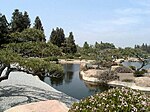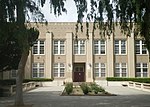Sepulveda station
2005 establishments in CaliforniaBus stations in Los AngelesG Line (Los Angeles Metro)Los Angeles Metro Busway stationsPublic transportation in Los Angeles ... and 2 more
Public transportation in the San Fernando ValleyVan Nuys, Los Angeles

Sepulveda station is a station on the G Line of the Los Angeles Metro Busway system. It is named after nearby Sepulveda Boulevard, which travels north-south and crosses the east-west busway route. Unique among G Line stations, Sepulveda's platforms are not located at the cross street, but rather about a block west of it. The station is in the Van Nuys neighborhood of the City of Los Angeles, in the central San Fernando Valley.
Excerpt from the Wikipedia article Sepulveda station (License: CC BY-SA 3.0, Authors, Images).Sepulveda station
Metro Orange Line Bikeway, Los Angeles Van Nuys
Geographical coordinates (GPS) Address External links Nearby Places Show on map
Geographical coordinates (GPS)
| Latitude | Longitude |
|---|---|
| N 34.1809 ° | E -118.4688 ° |
Address
Sepulveda
Metro Orange Line Bikeway
91411 Los Angeles, Van Nuys
California, United States
Open on Google Maps











